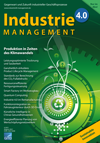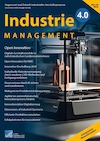Search


Bibtex
Cite as text
@Article{Sprenger+Klein+Wurster+Stricker+Lanza+Furmans,
Cite-key = "Sprenger2021",
Year= "2021",
Number= "4",
Volume= "37",
Pages= "37-40",
Journal = "Industrie 4.0 Management",
Title= "Industrie 4.0 im Remanufacturing: Analyse und Bewertung aktueller Forschungsansätze",
Author= "Kim Sprenger, Jan-Felix Klein, Marco Wurster, Nicole Stricker, Gisela Lanza und Kai Furmans",
Doi= "https://doi.org/10.30844/I40M_21-4_S37-40",
Abstract= "Das Remanufacturing, bisher geprägt durch manuelle und kostenintensive Prozesse, ist ein entscheidender Schritt auf dem Weg zu einer ressourcenschonenden Kreislaufwirtschaft. Industrie und Forschung sind sich einig, dass der Einzug von Industrie 4.0 Technologien den Schlüssel zu einer Entwicklung automatisierter und wirtschaftlicher Remanufacturing-Systeme darstellt. Basierend auf einer systematischen Literaturrecherche widmet sich dieser Beitrag der Analyse vielversprechender Industrie 4.0-Ansätze mit dem Fokus auf den übergeordneten Gesamtprozess sowie den Teilprozessen der Demontage und der Inspektion. Die Ergebnisse legen nahe, dass es an zusätzlichem Wissen, Erfahrung und Forschung bei der Entwicklung und realen Demonstration der Ansätze und deren Übertragbarkeit auf breitere Anwendungsfelder bedarf.",
Keywords= "Remanufacturing, Industrie 4.0, Automatisierung, Internet der Dinge, Literaturrecherche",
}
Kim Sprenger, Jan-Felix Klein, Marco Wurster, Nicole Stricker, Gisela Lanza und Kai Furmans(2021): Industrie 4.0 im Remanufacturing: Analyse und Bewertung aktueller Forschungsansätze. 374(2021), S. 37-40. Online: https://doi.org/10.30844/I40M_21-4_S37-40 (Abgerufen 24.12.25)
Open Access
Abstract
Abstract
Das Remanufacturing, bisher geprägt durch manuelle und kostenintensive Prozesse, ist ein entscheidender Schritt auf dem Weg zu einer ressourcenschonenden Kreislaufwirtschaft. Industrie und Forschung sind sich einig, dass der Einzug von Industrie 4.0 Technologien den Schlüssel zu einer Entwicklung automatisierter und wirtschaftlicher Remanufacturing-Systeme darstellt. Basierend auf einer systematischen Literaturrecherche widmet sich dieser Beitrag der Analyse vielversprechender Industrie 4.0-Ansätze mit dem Fokus auf den übergeordneten Gesamtprozess sowie den Teilprozessen der Demontage und der Inspektion. Die Ergebnisse legen nahe, dass es an zusätzlichem Wissen, Erfahrung und Forschung bei der Entwicklung und realen Demonstration der Ansätze und deren Übertragbarkeit auf breitere Anwendungsfelder bedarf.
Keywords
Schlüsselwörter
Remanufacturing, Industrie 4.0, Automatisierung, Internet der Dinge, Literaturrecherche
References
Referenzen
[1] Chakraborty, K.; Mondal, S. u. a.: A study on remanufacturing possibility of a product. In: Microsystem Technologies 25 (2019) 5, S. 1765–1770.
[2] Steinhilper, R.: Remanufacturing: The ultimate form of recycling. Stuttgart 1998.
[3] Ijomah, W. L.; McMahon, C. A. u. a.: Development of robust design-for-remanufacturing guidelines to further the aims of sustainable development. In: International Journal of Production Research 45 (2007) 18-19, S. 4513–4536.
[4] Huang, W.; Jiang, Z. u. a.: Remanufacturing Scheme Design for Used Parts Based on Incomplete Information Reconstruction. In: Chinese Journal of Mechanical Engineering 33 (2020).
[5] Kerin, M.; Pham, D. T.: Smart remanufacturing: a review and research framework. In: JMTM 31 (2020) 6, S. 1205–1235.
[6] Yang, S.; M. R., A. u. a.: Opportunities for Industry 4.0 to Support Remanufacturing. In: Applied Sciences 8 (2018) 7, S. 1177.
[7] Pistorius, J.: Industrie 4.0 – Schlüsseltechnologien für die Produktion: Grundlagen • Potenziale • Anwendungen, 1. Auflage. Berlin, Heidelberg 2020.
[8] Sundin, E.; Elo, K. u. a.: Design for automatic end-of-life processes. In: Assembly Automation 32 (2012) 4, S. 389–398.
[9] Wang, X. V.; Wang, L.: From Cloud manufacturing to Cloud remanufacturing: A Cloud-based approach for WEEE recovery. In: Manufacturing Letters 2 (2014) 4, S. 91–95.
[10] Wang, X. V.; Wang, L.: WRCloud: A Novel WEEE Remanufacturing Cloud System. In: Procedia CIRP 29 (2015), S. 786–791.
[11] Wang, X. V.; Wang, L.: Digital twin-based WEEE recycling, recovery and remanufacturing in the background of Industry 4.0. In: International Journal of Production Research 57 (2019) 12, S. 3892–3902.
[12] Fang, H. C.; Ong, S. K. u. a.: Use of Embedded Smart Sensors in Products to Facilitate Remanufacturing. In: Handbook of Manufacturing Engineering and Technology. (Hrsg): Nee, A. Y. C. London 2015, S. 3265–3290.
[13] Zhou, W.; Piramuthu, S.: Remanufacturing with RFID item-level information: Optimization, waste reduction and quality improvement. In: International Journal of Production Economics 145 (2013) 2, S. 647–657.
[14] Zhang, Y.; Liu, S. u. a.: The ‘Internet of Things’ enabled real-time scheduling for remanufacturing of automobile engines. In: Journal of Cleaner Production 185 (2018), S. 562–575.
[15] Okorie, O.; Charnley, F. u. a.: Towards a simulation-based understanding of smart remanufacturing operations: a comparative analysis. In: Jnl Remanufactur (2020).
[16] Ondemir, O.; Gupta, S. M.: Quality management in product recovery using the Internet of Things: An optimization approach. In: Computers in Industry 65 (2014) 3, S. 491–504.
[17] Groß, S.; Gerke, W. u. a.: Agent-based, hybrid control architecture for optimized and flexible production scheduling and control in remanufacturing. In: Jnl Remanufactur (2020).
[18] French, R.; Benakis, M. u. a.: Intelligent sensing for robotic re-manufacturing in aerospace — An industry 4.0 design based prototype. In: 2017 IEEE International Symposium on Robotics and Intelligent Sensors (IRIS). Ottawa, ON, S. 272–277.
[19] Ruggeri, S.; Fontana, G. u. a.: Micro-robotic Handling Solutions for PCB (re-)Manufacturing. In: Procedia Manufacturing 11 (2017), S. 441–448.
[20] Huang, J.; Pham, D. u. a.: A strategy for human-robot collaboration in taking products apart for remanufacture. In: FME Transactions 47 (2019) 4, S. 731–738.
[21] Li, R.; Ji, C. u. a.: Unfastening of Hexagonal Headed Screws by a Collaborative Robot. In: IEEE Trans. Automat. Sci. Eng. (2020), S. 1–14.
[22] Gerbers, R.; Wegener, K. u. a.: Safe, Flexible and Productive Human-Robot-Collaboration for Disassembly of Lithium-Ion Batteries. In: Sustainable production, life cycle engineering and management, Recycling of Lithium-Ion Batteries. (Hrsg): Kwade, A. und Diekmann, J. Cham 2018, S. 99–126.
[23] Bdiwi, M.; Rashid, A. u. a.: Autonomous disassembly of electric vehicle motors based on robot cognition. In: 2016 IEEE International Conference on Robotics and Automation (ICRA). Stockholm, Sweden, S. 2500–2505.
[24] Jungbluth, J.; Plapper, P. u. a.: Demontage von Elektroantrieben mit Assistenzrobotern zum wirtschaftlichen Recycling. In: Tagungsband AALE 2016 (2016), S. 10.
[25] Vongbunyong, S.; Kara, S. u. a.: Basic behaviour control of the vision-based cognitive robotic disassembly automation. In: Assembly Automation 33 (2013) 1, S. 38–56.
[26] Vongbunyong, S.; Kara, S. u. a.: Learning and revision in cognitive robotics disassembly automation. In: Robotics and Computer-Integrated Manufacturing 34 (2015), S. 79–94.
[27] Vongbunyong, S.; Vongseela, P. u. a.: A Process Demonstration Platform for Product Disassembly Skills Transfer. In: Procedia CIRP 61 (2017), S. 281–286.
[28] Rieß, S.; Laub, J. u. a.: Demontageeffektor für Schraubverbindungen mit ungewissem Zustand. In: ZWF 115 (2020) 10, S. 711–714.
[29] Chang, M. M. L.; Nee, A. Y. C. u. a.: Interactive AR-assisted product disassembly sequence planning (ARDIS). In: International Journal of Production Research 58 (2020) 16, S. 4916–4931.
[30] Chang, M.; Ong, S. K. u. a.: AR-guided Product Disassembly for Maintenance and Remanufacturing. In: Procedia CIRP 61 (2017), S. 299–304.
[31] Mircheski, I.; Rizov, T.: Improved Nondestructive Disassembly Process using Augmented Reality and RFID Product/Part Tracking. In: TEM Journal 6 (2017) 4, S. 671–676.
[32] Bentaha, M. L.; Dolgui, A. u. a.: Profit-oriented partial disassembly line design: dealing with hazardous parts and task processing times uncertainty. In: International Journal of Production Research 56 (2018) 24, S. 7220–7242.
[33] Liu, M.; Liu, X. u. a.: Robust disassembly line balancing with ambiguous task processing times. In: International Journal of Production Research 58 (2020) 19, S. 5806–5835.
[34-44] Aus Platzgründen sind diese Referenzen online unter www.ifl.kit.edu/industrie_4_0_management.php abrufbar.

 English
English